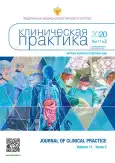Difficulties in treatment of acute coronary syndrome in a patient with end-stage chronic renal failure on program hemodialysis (case description)
- Authors: Bocharov A.V.1, Sidorov D.V.1, Popov L.V.2
-
Affiliations:
- Kostroma Regional Clinical Hospital named after Korolev E.I.
- National Medical and Surgical Center named after N.I. Pirogov
- Issue: Vol 11, No 3 (2020)
- Pages: 102-106
- Section: Case reports
- URL: https://journals.rcsi.science/clinpractice/article/view/33946
- DOI: https://doi.org/10.17816/clinpract33946
- ID: 33946
Cite item
Full Text
Abstract
Background. The surgical treatment of the coronary heart disease (acute coronary syndrome) in patients undergoing program hemodialysis has its own characteristics, which are not fully reflected in the cardiological recommendations. In particular, coronary artery bypass grafting is preferable to stenting, the drug of choice among p2y12 platelet receptor blockers is clopidogrel, with the infeasibility of rosuvastatin prescription. All these points are often ignored by treating doctors from the cardiology team when choosing the optimal treatment strategy for patients in this group.
Description of the clinical case. The article presents a case of treating acute coronary syndrome in a patient undergoing program hemodialysis. The problems of coronary revascularization and the drug therapy in this category of patients are discussed, and the ways to solve them are shown by the example of this clinical case.
Conclusion. In special cases, such as acute coronary syndrome in patients with chronic renal failure who are on program hemodialysis, the endovascular treatment strategy should be considered only if the specifics of the prescribed pharmacotherapy are taken into account.
Full Text
##article.viewOnOriginalSite##About the authors
Aleksandr V. Bocharov
Kostroma Regional Clinical Hospital named after Korolev E.I.
Author for correspondence.
Email: bocharovav@mail.ru
ORCID iD: 0000-0002-6027-2898
SPIN-code: 6073-1445
MD, PhD
Russian Federation, KostromaDenis V. Sidorov
Kostroma Regional Clinical Hospital named after Korolev E.I.
Email: denis.sidorov1972@mail.ru
Russian Federation, Kostroma
Leonid V. Popov
National Medical and Surgical Center named after N.I. Pirogov
Email: popovcardio@mail.ru
ORCID iD: 0000-0002-0530-3268
MD, PhD, Professor
Russian Federation, MoscowReferences
- Neumann FJ, Sousa-Uva M, Ahlsson A, et al. 2018 ESC/EACTS Guidelines on myocardial revascularization. Eur Heart J. 2019;40(2):87–165. doi: 10.1093/eurheartj/ehy394.
- Roffi M, Patrono C, Collet JP, et al. 2015 ESC Guidelines for the management of acute coronary syndromes in patients presenting without persistent ST-segment elevation. Eur Heart J. 2016;37(3):267–315. doi: 10.1093/eurheartj/ehv320.
- SyntaxScore II. Calculator version 2.28. Specify which segments are diseased for lesion 1. Available from: http://www.syntaxscore.com/calculator/syntaxscore/frameset.htm.
- SyntaxScore II. Calculator version 2.28. SYNTAX SCORE II 4-year mortality. Available from: http://www.syntaxscore.com/calculator/syntaxscore/framesetss2.htm.
- Sud M, Naimark DM. Cardiovascular disease in chronic kidney disease in 2015. Curr Opin Nephrol Hypertens. 2016;25(3):203–207. doi: 10.1097/MNH.0000000000000213.
- Барбараш О.Л., Зыков М.В., Быкова И.С., и др. Роль дисфункции почек и мультифокального атеросклероза в оценке прогноза у больных инфарктом миокарда и подъемом сегмента ST // Кардиология. — 2013. — Т.53. — №9. — С. 26–32. [Barbarash OL, Zykov MV, Byrova IS, et al. Role of renal dysfunction and multifocal atherosclerosis in assessment of prognosis of patients presenting with ST-elevation acute coronary syndrome. Kardiologiya. 2013;53(9):26–32. (In Russ).]
- Churchill DN, Taylor DW, Cook RJ. Canadian hemodialysis morbidity study. Am J Kidney Dis. 1992;19(3):214–234. doi: 10.1016/s0272-6386(13)80002-9.
- Bangalore S, Guo Y, Samadashvili Z, et al. Revascularization in patients with multivessel coronary artery disease and chronic kidney disease: everolimus-eluting stents versus coronary artery bypass graft surgery. J Am Coll Cardiol. 2015;66(11):1209–1220. doi: 10.1016/j.jacc.2015.06.1334.
- Shroff GR, Solid CA, Herzog CA. Long-term survival and repeat coronary revascularization in dialysis patients after surgical and percutaneous coronary revascularization with drug-eluting and bare metal stents in the Unites States. Circulation. 2013;127(18):1861–1869. doi: 10.1161/CIRCULATIONAHA.112.001264.
- Hiremath S, Holden RM, Fergusson D, Zimmerman DL. Antiplatelet medications in hemodialysis patients: a systematic review of bleeding rates. Clin J Am Soc Nephrol. 2009;4(8):1347–1355. doi: 10.2215/CJN.00810209.
- Summaria F, Giannico MB, Talarico GP, Patrizi R. Antiplatelet therapy in hemodialysis patients undergoing percutaneous coronary interventions. Nephrourol Mon. 2015;7(4):e28099. doi: 10.5812/numonthly.28099.
Supplementary files











